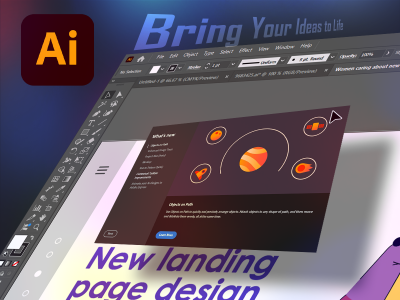 Feb 08, 2025 - 0 Minutes read
Feb 08, 2025 - 0 Minutes read
Bring Your Ideas to Life: Adobe Illustrator for Flyers and Infographic Design
Adobe Illustrator is used to create various design projects, including flyers, posters, and infographics. It helps you combine text and graphics, creating visually appealing layouts. With tools like the Shape Builder and Pen Tool, you can create custom graphics that make your designs unique. Illustrator also offers flexibility and precision when designing for print or digital platforms.
If you're new to Illustrator, no worries; plenty of tutorials will guide you through the basics.
Some of our links may be affiliate links and if you buy through our link, we might generate some commissions.
1. Setting Up Your Canvas
Every design begins with the right canvas. In Adobe Illustrator, setting up your canvas is quick and straightforward. Follow these steps to start your project:
Steps to follow:
- Open Adobe Illustrator and create a new document.
- Choose the appropriate size for your project (e.g., A4 for flyers, square for social media posts).
- Adjust the artboard using the Artboard Tool to fit your design needs. A well-set artboard keeps your design structured and easy to edit
2. Adding Text and Graphics
Text and graphics are crucial elements of any design; their effective integration is where the magic happens. Illustrator offers tools to arrange them proficiently.
Steps to follow:
- Use the Text Tool to insert and format text.
- Add visuals using the Shape Tool, icons, or imported images.
- Align elements neatly with alignment tools for a clean, professional look.
Pairing text with graphics enhances clarity and impact, making your design visually engaging.
Discover Adobe's suite of products.
3. Choosing Fonts and Colors
Fonts and colors play a vital role in design aesthetics. Illustrator offers a variety of customization options. To make your design look professional and eye-catching, follow these steps:
Steps to follow:
- Select fonts that match your design style. Use bold fonts for headlines and clean, readable fonts for details.
- Pick colors that complement your theme. Bright colors grab attention, while softer tones create a professional look.
- Use the color palette to experiment with different shades.
Choosing the right combination of fonts and colors improves readability and design appeal
4. Organizing Your Design with Layers
Using layers keeps your project manageable and makes editing easier.
Steps to follow:
- Separate elements (text, images, backgrounds) into different layers for better organization.
- Lock layers you’re not editing to prevent accidental changes.
Layers help maintain order in complex designs and streamline the editing process.
Discover Adobe's suite of products.
5. Adding Simple Visual Elements
Visual elements such as shapes, icons, and illustrations enhance designs. Adding visuals makes your designs more engaging and easy to understand. Adding charts, arrows, or icons can also clarify your message. These elements are beneficial in infographics or flyer design Illustrator projects.
Steps to follow:
- Use the Shape Builder or Pen Tool to create custom graphics.
- Incorporate charts, arrows, or icons to simplify complex information.
- Ensure elements align well for a balanced layout.
Adding visuals makes designs more engaging while keeping information easy to digest.
Discover Adobe's suite of products.
6. Saving and Exporting Your Design
Once your design is complete, saving and exporting it correctly ensures high-quality output. This process is simple.
Steps to follow:
- Review your design to check for alignment and missing elements.
- Choose the proper file format:
- PDF for print (flyers, posters).
- PNG or JPEG for digital use (websites, social media).
- Resize if needed to fit platform-specific dimensions. Now, your projects will look polished and ready to impress.
Proper exporting ensures your design maintains its quality across different formats.
Discover Adobe's suite of products.
Adobe Illustrator offers a wide range of tools to create professional designs efficiently. It gives you everything you need to bring your ideas to life. Whether working on print materials or digital graphics, its features provide flexibility for all design needs.
Illustrator tutorials help simplify the learning process for beginners. Of course, experimenting with fonts, colors, and layouts will enhance your design skills over time.
Start exploring Adobe Illustrator and let your creativity shine!